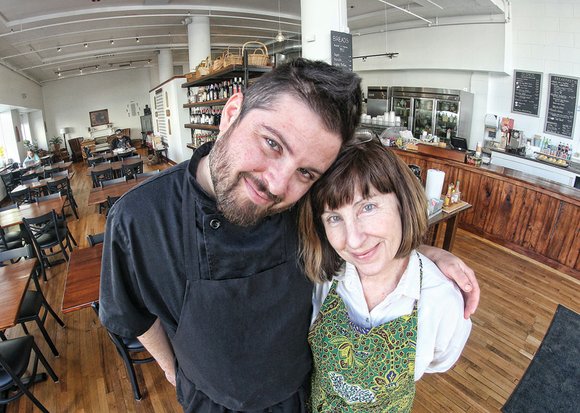City changes
Richmond population grows; it’s no longer majority black
Jeremy M. Lazarus | 3/31/2016, 8:48 p.m.

After growing up in Richmond, Patti B. Wright joined the wave of people leaving the city for the suburbs when her son, Joshua M. “Josh” Wright, was a toddler.
But now that her son is grown, she felt “it no longer made sense to live out in the country at the end of a dirt road.”
That’s why the 63-year-old retired schoolteacher sold her three-bedroom cottage near Pocahontas State Park in Chesterfield County and bought an apartment in the former Miller & Rhoads building in the heart of Downtown.
“I love it,” she said. Plus, her new home sits just across the street from Pop’s Market, the relaxed café her son opened last year and where she now pitches in to help make it a success.
Ms. Wright is part of the returning wave of “empty-nesters,” who along with a wave of newcomers with a penchant for urban living, have helped swell Richmond’s population to its highest level in 36 years — a big reason the boom in apartment and home construction is continuing in the capital city.
In data released last week, the Census Bureau estimated 220,289 people live in Richmond as of 2015, the most since at least 1979. The numbers confirm a Free Press projection published last summer.
The new estimate indicates the number of city residents has increased by 16,075 people, or 7.9 percent, since the last official count in 2010. At that time, 204,214 people were counted as living in Richmond — making it the state’s fourth most populous city after Virginia Beach, Norfolk and Chesapeake.
Based on the data, the increase in Richmond’s population is being fueled largely by growth in the white and Latino populations, creating a more diverse city.
As a result, African-Americans, who are estimated to number 108,293 people, no longer are a majority in Richmond.
Since 2010, the African-American population has slipped from 50.6 percent of the population to 49.7 percent of city residents, one of the lowest percentages since the 1980s.
According to the census, between 2010 and 2014, the percentage of people estimated to be white, including Latinos, rose from 40.8 percent to 44.7 percent, or by about 14,000 people to reach 97,380 people.
Only when the 2.2 percent of people who consider themselves being of two or more races are included does the African-American population comprise a slight majority.
“I don’t feel that makes much of a difference” whether Richmond is majority African-American or not, said former state Sen. Henry L. Marsh III, who made history in 1977 when he became the city’s first black mayor.
At the time, he was one of the five African-Americans who formed the first nonwhite majority on Richmond City Council that ushered in changes in employment and policies that transformed City Hall.
Mr. Marsh, a retired civil rights attorney, went on to serve Richmond in the state Senate for 22 years and now is a member of the state Alcoholic Beverage Control Board. He said times have changed. He noted that the African-American community that was once concentrated in the city has spread into Henrico and Chesterfield counties, making the region more diverse than it was in 1977.
The fact that African-Americans no longer hold a majority in the city should not have much impact.
“It’s more complicated than race,” Mr. Marsh said, noting that simply having African-Americans as officeholders or in the city administration is no guarantee the community would benefit.
He called “it more important to have officials who want to help, who are sensitive to community needs and understand issues like poverty. There are black people I wouldn’t want to represent me, and there are white people I wouldn’t want to represent me. But there are also black and white people I would. Race is just one factor.”
The census data also shows that 6.6 percent of Richmond residents are estimated to be Latino, while about 2.4 percent are Asian. Less than 1 percent are estimated to be either American Indian or Pacific islanders
The growth in Richmond’s population signals a new day. The city’s population peaked at 249,621 in 1970 after Richmond annexed a portion of Chesterfield County. Then the population began to shrink as people left, first from “white flight” from school desegregation and later from “black flight” to the suburbs.
By 2000, the city’s population had fallen to 197,790, the lowest since around 1942 during World War II.
Then, the turnaround began, slowly at first and then at a faster pace. Between 2000 and 2010, the city added an average of 642 people a year.
On average, the city has added about 2,600 residents a year since 2010. If the growth continues, the city’s population would top 232,000 when the next official count is conducted in 2020.
People such as Brian K. Chestnut now view the city as a refuge from stressful commutes.
Tired of battling increasingly congested rush hour traffic to get to and from his job in Downtown, Mr. Chestnut gave up his apartment in the Short Pump area of Henrico County last year and relocated to a house he rents on Richmond’s North Side.
“Now it takes me 10 minutes to get to work instead of 30 to 40 minutes,” said the 48-year-old civil engineer. “And my new place is great. Surprisingly, at night, it’s as quiet as the place I used to live. And the neighbors have been welcoming.”
The growth in Richmond has not halted population increases in the city’s closest neighbors. Since 2010, Henrico County has added about 19,000 residents, according to the census estimate, and had 325,155 residents as of 2015.
Chesterfield County has added about 19,300 people to reach 335,687 as of 2015, the county’s new estimate states.







